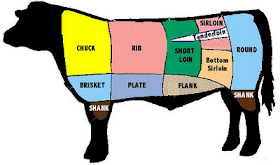I guess most high school and college curriculums don’t require beef or pork anatomy. I don’t really know why that is, but as a result, most of the general public doesn’t have any idea where their cuts come from or why they taste the way they do.
Steaks we see at a steak house restaurant.
Ribeye. This is undoubtedly my favorite cut of meat. Beef, pork, chicken, whatever! I would never turn down a ribeye. Very juicy and tender, the ribeye is the muscle attached to the ribs, close to the back bone. Technically, ribeye steaks are boneless, but lots of restaurants offer bone-in ribeyes. I like them boneless because they are cooked more evenly.
Most ribeye steaks will have an oval-shaped muscle and a smaller, crescent-shaped muscle circling it. That smaller muscle is called the spinalis and is extra tasty. So, if you are splitting your ribeye steak, be sure to offer the half without it to your friend. And, what they don’t know, can improve your eating experience.
New York Strip/ Kansas City Strip. I’ve only been to NYC once, but I’ve been to Kansas City several times, and I can tell you from my visits and from watching countless episodes of Law and Order that those two cities are not a whole lot alike. On the other hand, New York Strips and Kansas City Strips are exactly the same, technically a Top Loin steak. It doesn’t matter which geographical locale associated with it.
Strips are the same muscle as that found in the ribeye, but the steaks are cut from further down the animal’s backbone, further away from the head (from the Short loin, where the lumbar vertebrae are). Usually boneless, strips are also relatively tender, but they don’t have the tasty spinalis attached. Sometimes they are narrower and have more connective tissue (gristle) than ribeyes. Because they are usually just one muscle, they are a leaner than the ribeyes (well, it’s easier to avoid the fa… not-lean parts).
T-bone. This is a favorite of lots of men. It’s BIG and it has a bone. Basically, the T-bone is the Strip and the Filet still stuck together with a bone in the middle. It’s a good one for sharing, especially if you and whoever you are sharing with don’t like your steaks cooked to the same degree of doneness. Generally, steaks are less done closer to the bone.
Sirloin. If I’m not in the mood (I don’t have enough money) for a ribeye, I usually order a sirloin. The story goes that an English king liked the steak so much that he knighted it, hence ‘sir’ loin. According to Wikipedia and Snopes.com, that’s not true. (It doesn’t mean you can’t pass the time telling the story to your kids while waiting on your meals at the steakhouse.)
The sirloin steaks are the very last steaks cut from the loin. Made from two large muscles, full-size sirloin steaks are very large, but are usually cut into smaller steaks for restaurants. At some places, you can order a sirloin steak as small as 6 oz. That’s uncooked weight, so the cooked weight should be between 3 and 4 oz (close to the suggested serving size).
Sirloin steaks are often marinated or flavored, which makes them tastier, but can it also add calories (like I care). Sirloin tips are from the same area, just cut up before they were cooked. Sirloin steaks are generally lean, but can be inconsistent in tenderness. When I cook them at home, I try to make sure I don’t overcook them.
Flat-iron. I love it when people say that the Flat-iron is a ‘new cut of beef’. Like cattle just suddenly started growing a new muscle. Really what happened was that some researchers decided that they would test the tenderness of every muscle in the animal, just to see. And SURPRISE! SURPRISE! There was a muscle in the shoulder (Chuck) that was really tender (2nd most tender in the animal, only one that beat it was the Filet). The scientific name for the Flat-iron is the Infraspinatus, and it is found right next to the shoulder blade. It has a big hunk of connective tissue (gristle) that runs right through the middle…problem. The folks at the National Cattlemen’s Beef Association (NCBA) worked on a new way to cut it to remove the connective tissue and so that it was a nice portion size, renamed it the ‘Flat-iron’, and started teaching the rest of us in the industry how to cut and prepare it. And POOF! a new steak!
The Flat-iron is always tender and juicy. Sometimes, if it isn’t cut correctly, some of the gristle gets left on it.


That’s pretty much it for ‘grillin’ steaks’ or steaks you will commonly find at restaurants. Several of these steaks are among the 29-cuts of lean beef that qualify for the USDA definition on ‘lean’. Those include the strip, the tenderloin, the T-bone, and sirloin steaks. So, go out and enjoy a good steak tonight.


What is flank steak?
ReplyDeleteThanks for the question.
DeleteFlank steak is an abdominal muscle. It's in front of the back leg.
It's great for fajitas or other dishes that have marinades. It has a coarse texture.